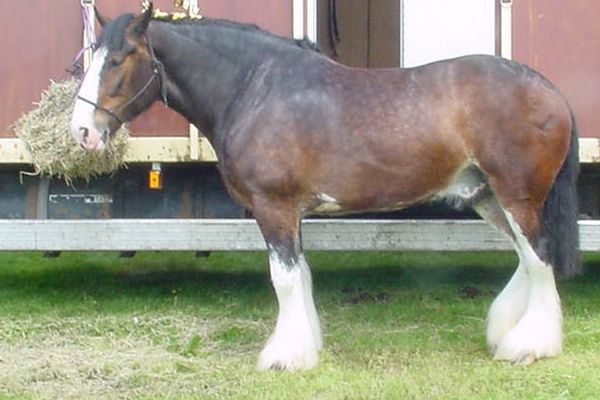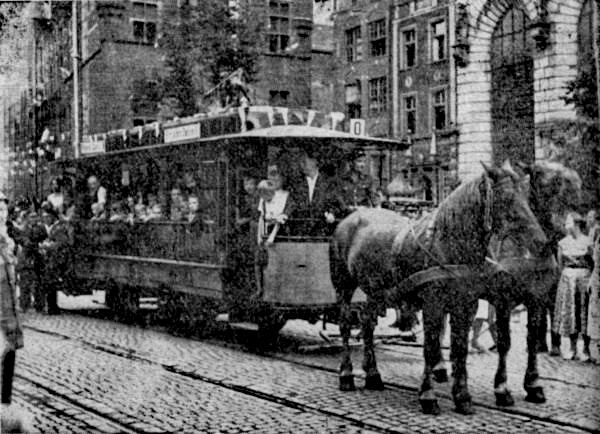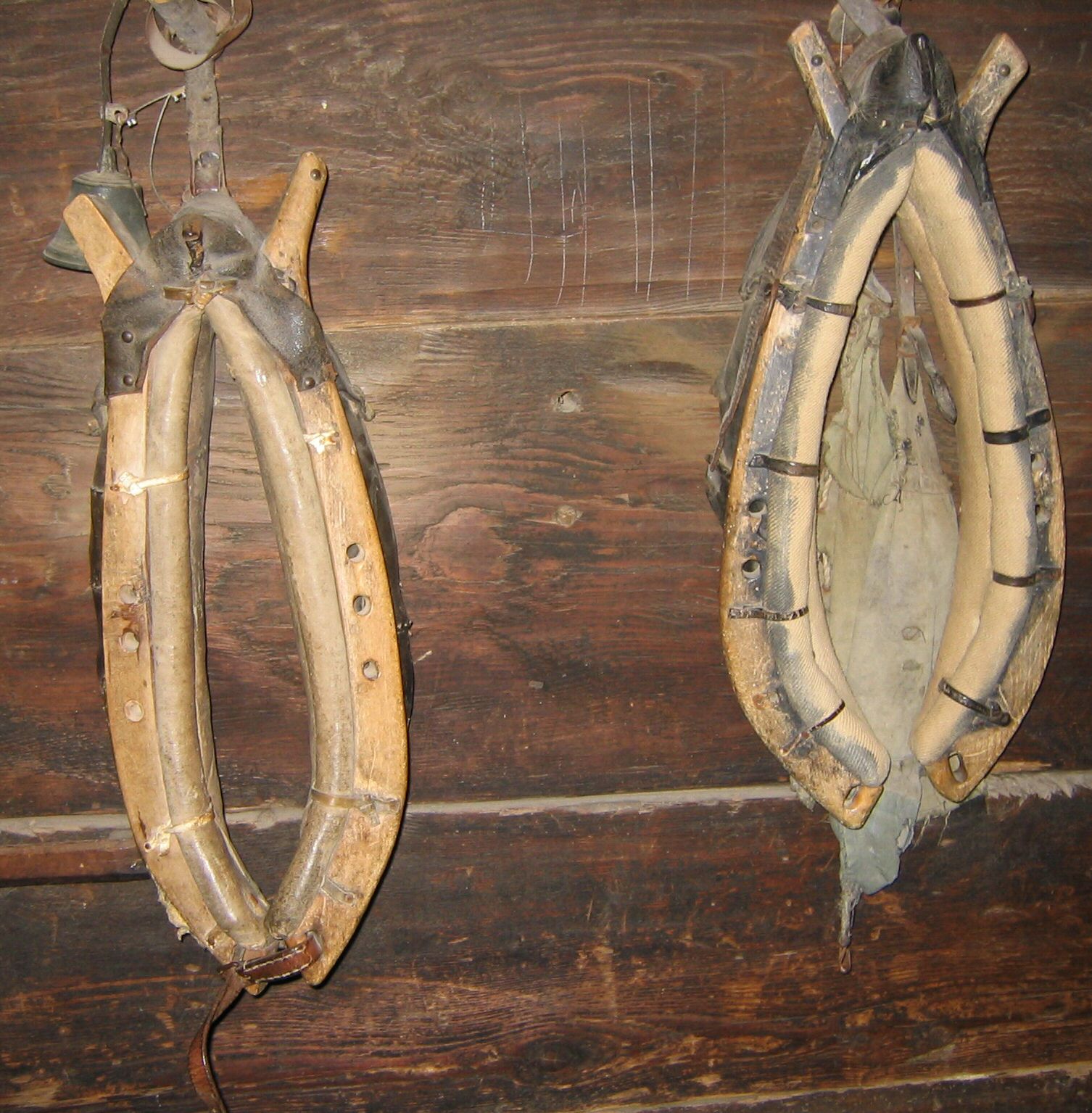|
Swingletree
{{Unreferenced, date=May 2019, bot=noref (GreenC bot) A swingletree (British Isles) or singletree (North America) is a wooden or metal bar used to balance the pull of a draught horse or other draught animal when pulling a vehicle. It is a kind of whippletree, and the term is also used sometimes for other whippletrees. It is a horizontal bar, attached or suspended in the middle, and able to hinge fore-and-aft in a horizontal plane. The traces (the straps by which the animal pulls) attach to its ends, and the vehicle is pulled from its middle. The centre of the swingletree may be bolted directly to the body of the vehicle, this bolt pulling the vehicle along. Alternatively it may hang loosely by a chain or strap from the body of the vehicle, and in this case the pull is taken by chains from the centre of the bar to the ends of the axle. The action of a swingletree is to balance the pull from alternate shoulders as the animal walks. It is used especially when the animal is in ... [...More Info...] [...Related Items...] OR: [Wikipedia] [Google] [Baidu] |
Whippletree (mechanism)
A whippletree, or whiffletree, is a mechanism to distribute force evenly through linkages. It is also referred to as an equalizer, leader bar, or double tree. It consists of a bar pivoted at or near the centre, with force applied from one direction to the pivot and from the other direction to the tips. Several whippletrees may be used in series to distribute the force further, such as to simulate pressure over an area as when applying loading to test airplane wings. Whippletrees may be used either in compression or tension. They were also used for subtraction and addition calculations in mechanical computers. Tension whippletrees are used in artful hung mobiles, such as those by artist Alexander Calder. Draught whippletrees Whippletrees are used in tension to distribute forces from a point load to the traces of draught animals (the traces are the chains or straps on each side of the harness, on which the animal pulls). For these, the whippletree consists of a loose horizo ... [...More Info...] [...Related Items...] OR: [Wikipedia] [Google] [Baidu] |
Horse Harness
Horse harness is a device that connects a horse to a vehicle or another type of load. There are two main categories of horse harness: (1) the "breaststrap" or "breastcollar" design, and (2) the collar and hames design. For light work, such as horse show competition where light carts are used, a harness needs only a breastcollar. It can only be used for lighter hauling, since it places the weight of the load on the sternum of the horse and the nearby windpipe. This is not the heaviest skeletal area; also heavy loads can constrict the windpipe and reduce a horse's air supply. By contrast, the collar and harness places the weight of the load onto the horse's shoulders, and without any restriction on the air supply. For heavy hauling, the harness must include a horse collar to allow the animal to use its full weight and strength. Harness components designed for other animals (such as the yoke used with oxen) are not suitable for horses and will not allow the horse to work effi ... [...More Info...] [...Related Items...] OR: [Wikipedia] [Google] [Baidu] |
Welsh Cob With Swingletree
Welsh may refer to: Related to Wales * Welsh, referring or related to Wales * Welsh language, a Brittonic Celtic language spoken in Wales * Welsh people People * Welsh (surname) * Sometimes used as a synonym for the ancient Britons (Celtic people) Animals * Welsh (pig) Places * Welsh Basin, a basin during the Cambrian, Ordovician and Silurian geological periods * Welsh, Louisiana, a town in the United States * Welsh, Ohio, an unincorporated community in the United States See also * Welch (other) * * * Cambrian + Cymru Wales ( cy, Cymru ) is a Countries of the United Kingdom, country that is part of the United Kingdom. It is bordered by England to the Wales–England border, east, the Irish Sea to the north and west, the Celtic Sea to the south west and the ... {{Disambiguation Language and nationality disambiguation pages ... [...More Info...] [...Related Items...] OR: [Wikipedia] [Google] [Baidu] |
Draft Horse
A draft horse (US), draught horse (UK) or dray horse (from the Old English ''dragan'' meaning "to draw or haul"; compare Dutch ''dragen'' and German ''tragen'' meaning "to carry" and Danish ''drage'' meaning "to draw" or "to fare"), less often called a carthorse, work horse or heavy horse, is a large horse bred to be a working animal doing hard tasks such as plowing and other farm labor. There are a number of breeds, with varying characteristics, but all share common traits of strength, patience, and a docile temperament which made them indispensable to generations of pre-industrial farmers. Draft horses and draft crossbreds are versatile breeds used today for a multitude of purposes, including farming, draft horse showing, logging, recreation, and other uses. They are also commonly used for crossbreeding, especially to light riding breeds such as the Thoroughbred, for the purpose of creating sport horses of warmblood type. While most draft horses are used for driving, ... [...More Info...] [...Related Items...] OR: [Wikipedia] [Google] [Baidu] |
Draught Animal
A working animal is an animal, usually domesticated, that is kept by humans and trained to perform tasks instead of being slaughtered to harvest animal products. Some are used for their physical strength (e.g. oxen and draft horses) or for transportation (e.g. riding horses and camels), while others are service animals trained to execute certain specialized tasks (e.g. hunting and guide dogs, messenger pigeons and fishing cormorants). They may also be used for milking or herding. Some, at the end of their working lives, may also be used for meat or other products such as leather. The history of working animals may predate agriculture, with dogs used by our hunter-gatherer ancestors. Around the world, millions of animals work in relationship with their owners. Domesticated species are often bred for different uses and conditions, especially horses and working dogs. Working animals are usually raised on farms, though some are still captured from the wild, such as dolphins an ... [...More Info...] [...Related Items...] OR: [Wikipedia] [Google] [Baidu] |
Horse-drawn Vehicle
A horse-drawn vehicle is a mechanized piece of equipment pulled by one horse or by a team of horses. These vehicles typically had two or four wheels and were used to carry passengers and/or a load. They were once common worldwide, but they have mostly been replaced by automobiles and other forms of self-propelled transport. General Horses were domesticated circa 3500 BCE. Prior to that oxen were used. Historically a wide variety of arrangements of horses and vehicles have been used, from chariot racing, which involved a small vehicle and four horses abreast, to horsecars or trollies, which used two horses to pull a car that was used in cities before electric trams were developed. A two-wheeled horse-drawn vehicle is a cart (see various types below, both for carrying people and for goods). Four-wheeled vehicles have many names – one for heavy loads is most commonly called a wagon. Very light carts and wagons can also be pulled by donkeys (much smaller than horses), p ... [...More Info...] [...Related Items...] OR: [Wikipedia] [Google] [Baidu] |
Hinge
A hinge is a mechanical bearing that connects two solid objects, typically allowing only a limited angle of rotation between them. Two objects connected by an ideal hinge rotate relative to each other about a fixed axis of rotation: all other translations or rotations being prevented, and thus a hinge has one degree of freedom. Hinges may be made of flexible material or of moving components. In biology, many joints function as hinges, like the elbow joint. History Ancient remains of stone, marble, wood, and bronze hinges have been found. Some date back to at least Ancient Egypt. In Ancient Rome, hinges were called cardō and gave name to the goddess Cardea and the main street Cardo. This name cardō lives on figuratively today as "the chief thing (on which something turns or depends)" in words such as ''cardinal''. According to the OED, the English word hinge is related to '' hang''. Door hinges ; Barrel hinge: A barrel hinge consists of a sectional barrel (the ... [...More Info...] [...Related Items...] OR: [Wikipedia] [Google] [Baidu] |
Trace (tack)
In transport, a trace is one of two, or more, straps, ropes or chains by which a carriage or wagon, or the like, is drawn by a harness horse or other draft animal. The once popular idiom: "kick over the traces" is derived from a frisky or frightened animal kicking one or both feet outside a trace. Unable to understand the entanglement, the animal may become wildly confused and out of control, possibly even breaking away. Hence, to "kick over the traces", when referring to a person, means to become wild and uncontrollable, or to abandon constraint. See also *Horse harness *Horse tack Tack is equipment or accessories equipped on horses and other equines in the course of their use as domesticated animals. This equipment includes such items as saddles, stirrups, bridles, halters, reins, bits, and harnesses. Equipping a horse ... Horse harness {{transport-stub ... [...More Info...] [...Related Items...] OR: [Wikipedia] [Google] [Baidu] |
Breastcollar
A breastplate (used interchangeably with breastcollar, breaststrap and breastgirth) is a piece of riding equipment used on horses. Its purpose is to keep the saddle or harness from sliding back. On riding horses, it is most helpful on horses with large shoulders and a flat ribcage. It is also a safety feature, especially on cross-country, should a rider's girth or billets break, as the rider will have enough time to stop the horse and dismount before the saddle slipped off the animal's back or underneath its belly. The breastplate is used on both English and Western saddles. When used in English riding, the hunting breastplate is made of thinner straps of leather, as is the western style used for horse shows. Working western horses in disciplines that involve work with cattle use a thicker, sturdier style. History When the Spanish Conquistador Cortez invaded Mexico in 1519 his small group of cavalry men all rode the old centerfire rigged War Saddle. Since the saddle was pr ... [...More Info...] [...Related Items...] OR: [Wikipedia] [Google] [Baidu] |
Horse Collar
A horse collar is a part of a horse harness that is used to distribute the load around a horse's neck and shoulders when pulling a wagon or plough. The collar often supports and pads a pair of curved metal or wooden pieces, called hames, to which the traces of the harness are attached. The collar allows the horse to use its full strength when pulling, essentially enabling the animal to push forward with its hindquarters into the collar. If wearing a yoke or a breastcollar, the horse had to pull with its less-powerful shoulders. The collar had another advantage over the yoke as it reduced pressure on the horse's windpipe. From the time of the invention of the horse collar, horses became more valuable for plowing and pulling. When the horse was harnessed in the collar, the horse could apply 50% more power to a task in a given time period than could an ox, due to the horse's greater speed.Needham, Volume 4, Part 2, 312. Additionally, horses generally have greater endurance tha ... [...More Info...] [...Related Items...] OR: [Wikipedia] [Google] [Baidu] |
Breastcollar
A breastplate (used interchangeably with breastcollar, breaststrap and breastgirth) is a piece of riding equipment used on horses. Its purpose is to keep the saddle or harness from sliding back. On riding horses, it is most helpful on horses with large shoulders and a flat ribcage. It is also a safety feature, especially on cross-country, should a rider's girth or billets break, as the rider will have enough time to stop the horse and dismount before the saddle slipped off the animal's back or underneath its belly. The breastplate is used on both English and Western saddles. When used in English riding, the hunting breastplate is made of thinner straps of leather, as is the western style used for horse shows. Working western horses in disciplines that involve work with cattle use a thicker, sturdier style. History When the Spanish Conquistador Cortez invaded Mexico in 1519 his small group of cavalry men all rode the old centerfire rigged War Saddle. Since the saddle was pr ... [...More Info...] [...Related Items...] OR: [Wikipedia] [Google] [Baidu] |
Draft Horse
A draft horse (US), draught horse (UK) or dray horse (from the Old English ''dragan'' meaning "to draw or haul"; compare Dutch ''dragen'' and German ''tragen'' meaning "to carry" and Danish ''drage'' meaning "to draw" or "to fare"), less often called a carthorse, work horse or heavy horse, is a large horse bred to be a working animal doing hard tasks such as plowing and other farm labor. There are a number of breeds, with varying characteristics, but all share common traits of strength, patience, and a docile temperament which made them indispensable to generations of pre-industrial farmers. Draft horses and draft crossbreds are versatile breeds used today for a multitude of purposes, including farming, draft horse showing, logging, recreation, and other uses. They are also commonly used for crossbreeding, especially to light riding breeds such as the Thoroughbred, for the purpose of creating sport horses of warmblood type. While most draft horses are used for driving, ... [...More Info...] [...Related Items...] OR: [Wikipedia] [Google] [Baidu] |







